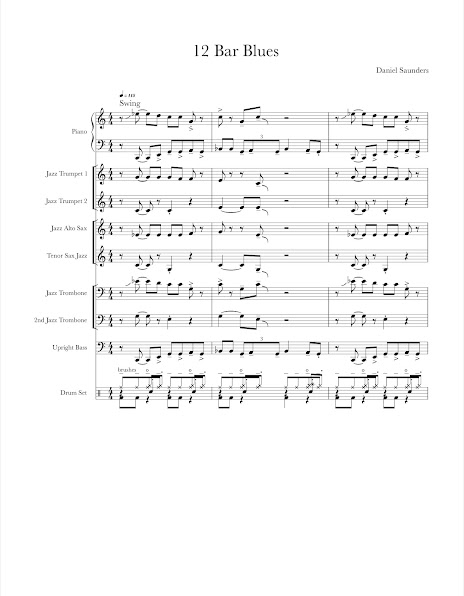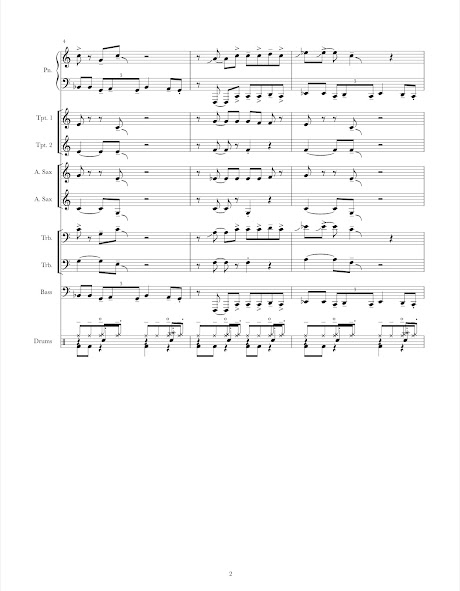Popular Music
Lesson 35
March 25th, 2022
Lesson 35
Lecture notes:
- The quaternary form is a song with four phrases. Each phrase is usually either four or eight measures long. If the phrases are eight measures each, the form would also be called the thirty-two-bar form. In this form, the first two phrases mostly always begin the same, differing only with an altered cadence when they're not entirely identical. The two phrases are followed by a contrasting section and then returned to the opening section.
- A visual example of the quaternary form is (a a b a). The (b) section is the contrasting section formally known as the bridge in this form.
- Quaternary songs can also be written in other designs such as (a b a c), which doesn't have a bridge, or (a b c b) and (a b c a), which utilizes (c) as the bridge.
- A refrain is a line or pair of lines that usually appear at the end of each verse with the same music and words.
- A refrain also includes what is known as a song's hook. This is usually a song's main idea, which is the most memorable part.
- Any triad or seventh chord can be extended in a diatonic scale. The two most common extensions used are the added sixth and ninth. Additionally, no matter the underlying harmony's quality, the added sixth and ninth are generally major. The added ninth can sometimes be a minor when the chord is a dominant seventh.
- Sometimes 4-3 suspensions are added to music without a resolution. In other words, an interval of a fourth is added above the bass note to displace the third but never resolves. This is formally known as a sus chord and is labeled sus or sus4.
- Triads or seventh chords can be colored and intensified by either lowering or raising a fifth of a chord by a half step, resulting in an augmented or diminished fifth between the root and fifth degree.
- The blues is an early twentieth-century song style that helped to influence popular music. It originated in the 1950s in the Mississippi Delta among African American musicians and became a global phenomenon in the music scene.
- Blues songs commonly feature a minor sounding vocal melody and are accompanied by chords in a parallel major key.
- The blues scale consists of six notes inclusive of (1, b3, 4, #4, 5, b7, 1 [ascending]) and (1, b7, 5, b5, 4, b3, 1 [descending]) respecfully.
- The pentatonic scale consists of five notes inclusive of (1, 3, 4, 5, 7, 1) ascending and descending.
- The most recognizable progression that makes up many blues compositions is the twelve-bar blues progression. A visual example of the progression is (I, I, I, I, IV, IV, I, I, V, IV, I, I or V7). When the phrase ends on a V7, it is used as a turnaround to take you back to the beginning.
- In jazz tunes, musicians sometimes get the opportunity to play improvised solos over the harmonic progressions. Upon completion, the song returns to the original recognizable melody, called the head.
The photo above shows the formula for the blues scale, showcasing each letter name scale using the blues formula. Photo Credit: Carlinton (https://www.choose-piano-lessons.com/blues-scale.html)
The photo above shows the 12-Bar blues progression in the key of F major. Photo Credit: (https://dictionary.onmusic.org/appendix/topics/12-bar-blues-chord-progression)
The video above explains what a minor blues scale is and how to construct it. The presenter uses the piano to give audible illustrations in his presentation, and he uses the A minor blues scale for his demonstration. Video Credit: Pianote (https://www.youtube.com/watch?v=Eosor-ncv7Y)
The video above explains the structure and form of a song. In addition, it outlines the various sections typically found in the makeup of a piece of music. The presenter also turned his explanation into a song and started with an introduction leading to a verse, then pre-chorus, chorus, verse, pre-chorus, chorus, instrumental break, bridge, chorus, and finally, the ending. Video Credit: Mr Morley Music Education (https://www.youtube.com/watch?v=oXifpcE7ewU)
The photos above are a composition I wrote over a 12-Bar Blues progression in the key of C major.
The video above is the midi recording of my composition for your enjoyment and convenience.







Comments
Post a Comment